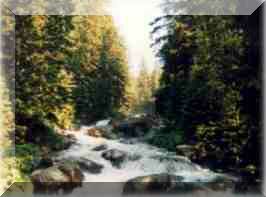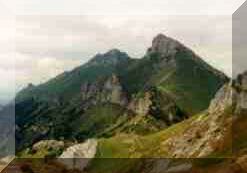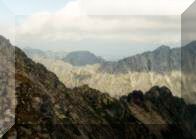

 Currently, its area amounts to 21,164 ha, out of which 15,124 ha (71.5%) are forests, and 5,660 ha (26.7%) are mostly communities of alpine meadows and rock towers. Arable land (171 ha) and waters (209) occupy in total 1.8% of the Park total area. Strict protection is excercised over 11,514 ha (54.4%), out of which 6,149 ha are forest ecosystems. The need to protection of the Tatra Mountains was first realised in the end of the 19th Century. In 1925 first efforts were made together with the Slovaks towards a creation of a national park. A national park was formally established in 1937 on lands that belonged to the state forests. After the World War 2, in 1947 an independent administrative unit Tatra National Park was established. In 1993 the Tatra National Park and the Tatransky Narodni Park on the Slovak side were recognised by UNESCO as an International MaB Reserve of global importance.
Currently, its area amounts to 21,164 ha, out of which 15,124 ha (71.5%) are forests, and 5,660 ha (26.7%) are mostly communities of alpine meadows and rock towers. Arable land (171 ha) and waters (209) occupy in total 1.8% of the Park total area. Strict protection is excercised over 11,514 ha (54.4%), out of which 6,149 ha are forest ecosystems. The need to protection of the Tatra Mountains was first realised in the end of the 19th Century. In 1925 first efforts were made together with the Slovaks towards a creation of a national park. A national park was formally established in 1937 on lands that belonged to the state forests. After the World War 2, in 1947 an independent administrative unit Tatra National Park was established. In 1993 the Tatra National Park and the Tatransky Narodni Park on the Slovak side were recognised by UNESCO as an International MaB Reserve of global importance.
 The Tatra Mountains owe their present look mostly to the Pleistocene glaciation period. Within the last 500 - 10 thousand years glaciers appeared and disappeared in this region. The highest peak of the Polish Tatra and the Park is Rysy (2,499 m a.s.l.). The Tatra is divided into two distinctive parts. The High Tatra range (Tatry Wysokie) is built of crystalline rocks. Its landscape is characterised by post-glacial forms: sharp rock towers and crests and numerous cirques, mostly occupied by lakes. The West Tatra range (Tatry Zachodnie) was formed from crystalline and sediment rocks. Its landscape consists of e.g. many picturesque valleys with remnant rocky forms. The Park contains about 650 caves. Wielka Onie?na - Wielka Litworowa cave is the longest (18,000 m) and the deepest (814 m in depth). 6 caves are accessible for visitors.
The Tatra Mountains owe their present look mostly to the Pleistocene glaciation period. Within the last 500 - 10 thousand years glaciers appeared and disappeared in this region. The highest peak of the Polish Tatra and the Park is Rysy (2,499 m a.s.l.). The Tatra is divided into two distinctive parts. The High Tatra range (Tatry Wysokie) is built of crystalline rocks. Its landscape is characterised by post-glacial forms: sharp rock towers and crests and numerous cirques, mostly occupied by lakes. The West Tatra range (Tatry Zachodnie) was formed from crystalline and sediment rocks. Its landscape consists of e.g. many picturesque valleys with remnant rocky forms. The Park contains about 650 caves. Wielka Onie?na - Wielka Litworowa cave is the longest (18,000 m) and the deepest (814 m in depth). 6 caves are accessible for visitors.
 They are an important feature of the High Tatra landscape. The largest ponds are Morskie Oko (34.5 ha of area, and 50.8 in depth) and Wielki Staw Polski (34.1 ha of area and 79.8 in depth). The lakes situated above the upper border of forest zone are characterised by very poor biological life and an unusual water transparency. The river network of the High Tatra is much more dense than in the West Tatra. The longest stream exceed 20 km of length. Waterfalls and rising springs are very often found and they are one of the Park attractions (e.g. Wodogrzmoty Mickiewicza). The largest waterfall is Wielka Siklawa (70 m).
They are an important feature of the High Tatra landscape. The largest ponds are Morskie Oko (34.5 ha of area, and 50.8 in depth) and Wielki Staw Polski (34.1 ha of area and 79.8 in depth). The lakes situated above the upper border of forest zone are characterised by very poor biological life and an unusual water transparency. The river network of the High Tatra is much more dense than in the West Tatra. The longest stream exceed 20 km of length. Waterfalls and rising springs are very often found and they are one of the Park attractions (e.g. Wodogrzmoty Mickiewicza). The largest waterfall is Wielka Siklawa (70 m).
 Most interesting are the chamoix and marmot, which have been protected since the mid 19th Century, as well as brown bear, and a number of bird species, including golden eagle, falcons, wall-creeper, alpine accentor. Higher parts of the forests are inhabited by capercaillie, black grouse, and hazel grouse. Red and roe deer as well as small rodents are common in the forests.
Most interesting are the chamoix and marmot, which have been protected since the mid 19th Century, as well as brown bear, and a number of bird species, including golden eagle, falcons, wall-creeper, alpine accentor. Higher parts of the forests are inhabited by capercaillie, black grouse, and hazel grouse. Red and roe deer as well as small rodents are common in the forests.
 Other threats to the natural assets of the Park include: poaching, development of sport and tourism facilities, and the economically growing town of Zakopane.
Other threats to the natural assets of the Park include: poaching, development of sport and tourism facilities, and the economically growing town of Zakopane.